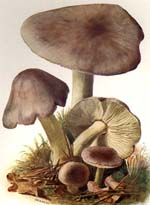Clitocybe clavipes
 Key to Gilled Mushrooms Key
Key to Gilled Mushrooms KeyThis is a key to gilled mushrooms, that is, mushrooms having a definite cap with a fertile surface consisting of gills. The fruiting body usually also has a stem, although that may be lateral or absent (usually, then, the mushroom is growing from wood). You can use this key to identify mushrooms that you find.
 Agaricales Order
Agaricales OrderFruiting body containing fibers (usually in the stalk)
 White Spored Suborder
White Spored SuborderSpore print "light-colored": white or buff, sometimes tinged with pink or tan. Greenish and (except for the Russulales) yellow spore prints also go here
Stalk fibrous, not fracturing like a piece of chalk
 Tricholomataceae Family
Tricholomataceae FamilyNone of the special features distinguishing the other white-spored genera:
Gills not free, as in the Lepiotas and Amanitas
Basidia not extra-long, as in the Hygrophoraceae
Spores smooth, except for Lentinellus
 Terrestrial Trich Subfamily
Terrestrial Trich SubfamilyGrowing on the ground
 Woodland Normal Trich Tribe
Woodland Normal Trich TribeFound in woods
Not rooting
 Clitocybe-like Fungi Subtribe
Clitocybe-like Fungi SubtribeGills attached to decurrent
Coloration usually white to greyish brown, sometimes purple or with purple tones
Never with a ring of any kind
 Clitocybe Genus
Clitocybe GenusGills attached to decurrent, crowded
Cap glabrous, small to very large; often aging into a funnel shape
Spore print often tinged with pink or buff
Look for things here if they have non-free gills and don't fit the other taxa
 Clubfoot Section
Clubfoot SectionStalk widening drastically towards the bottom, often until it is as wide as the cap
Cap conical when young, flat with a very broad umbo in maturity
Gills strongly decurrent, often slanting diagonally from the margin to the stalk
Thus, the point where the gills meet the stalk is usually the thinnest part of the mushroom, and young mushrooms have sort of an hourglass-shaped profile
Here are the characters that distinguish this species from the others in its group. For its more general characters, see higher up on the page.
If there's just a few words or a microscopic feature here, a more thorough description can be found above.
Diagnosis
- Cap greyish brown or olive brown
-
Gills and stem white, base often spongy and covered with downy white mycelium
-
In woods, usually under conifers
Microscropic Characters
Comments
Some people eat this mushroom, which is ill-advised: it can cause bad reactions in conjunction with alcohol, and there are many look-alikes of unknown edibility that can only be distinguished from it microscopically






 Key to Gilled Mushrooms Key
Key to Gilled Mushrooms Key Agaricales Order
Agaricales Order White Spored Suborder
White Spored Suborder Tricholomataceae Family
Tricholomataceae Family Terrestrial Trich Subfamily
Terrestrial Trich Subfamily Woodland Normal Trich Tribe
Woodland Normal Trich Tribe Clitocybe-like Fungi Subtribe
Clitocybe-like Fungi Subtribe Clitocybe Genus
Clitocybe Genus Clubfoot Section
Clubfoot Section




